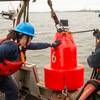Pioneering trials measuring the ship evacuation performance of passengers in conditions including smoke and rolling motion, are being conducted as part of a research project led by British Maritime Technology Ltd (BMT) and co-funded by the European Union FP5 Competitive and Sustainable Growth program and Precarn (funding for Canadian partners).
The aim is to produce a FIRE-EXIT simulation tool that will equip the marine industry with a ship evacuation, fire and abandonment simulation tool that is a significant improvement over the level of reliability, realism and design utility available from existing systems. The software will enable the design of safer vessels, optimisation of ship layout and emergency procedures and will also assist in ensuring that, in the event of a fire, passengers move as quickly and safely as possible to their assigned lifeboat stations.
For the first time a large-scale, smoke-filled test facility capable of dynamic motion superimposed over an angle of heel is being used with volunteer "passengers" for live trials. This follows major enhancements to the Ship Evacuation Behaviour Assessment (SHEBA) facility which provides a uniquely realistic insight into the evacuation process.
This represents a pivotal stage for the EU FIRE-EXIT (formulation of immediate response and evacuation strategies through intelligent simulation assessment and large-scale testing) project, aimed at improving ship safety.
Full-scale abandonment trials are also being conducted in Canada. Volunteers are timed and behaviour videotaped as they escape from muster stations via inflatable slides and vertical chutes as they cross a
collection platform and enter life rafts and lifeboats. Model tests have been performed to measure lifeboat launching performance in high sea states.
Data collected from these trials is being incorporated within the maritimeEXODUS ship evacuation software and the fire simulation software SMARTFIRE, both of which are developed by the Fire Safety Engineering Group (FSEG) of the University of Greenwich, which is also part of the research
consortium.
Work to date has also highlighted the fact that the software will be useful not only in incorporating higher levels of safety at the earlier stages of design, but also in enabling owners to reassess plans for passenger movement. With potential for use in planning routine movements such as boarding or movement at meal times on large passenger ships, this could lead to smoother onboard operations in general.
The three-year FIRE-EXIT project is scheduled to finish in August 2005 and demonstrations are likely to be available by the end of the year. FIRE-EXIT will be of particular assistance in meeting the more rigorous legislative measures seeking to increase maritime safety, which have recently been
established by the EU. For example, Council Directive 98/18/EC sets out requirements for new class B, C and D ro-ro passenger ships to have escape routes evaluated by an evacuation analysis early in the design process.
The FIRE-EXIT consortium also includes the University of Greenwich, AVEVA AB, BMT Fleet Technology Ltd, Det Norske Veritas, the METTLE Groupe, the Marine Institute at the Memorial University Newfoundland and the Institute for Ocean Technology at the National Research Council of Canada.
Sponsored Content
LR - Fit for 55: Managing compliance and optimising operations

Use Roxtec seals, services and software

Subscribe for
Maritime Reporter E-News
Maritime Reporter E-News is the maritime industry's largest circulation and most authoritative ENews Service, delivered to your Email five times per week









